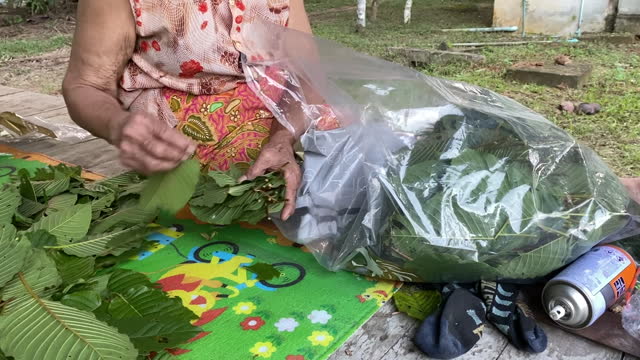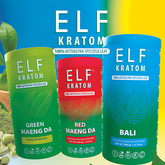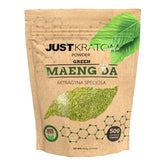Is kratom tea the latest wonder drug?
Or is that kava? Or kanna? It’s getting hard to keep track of all these “new” herbal miracles.
This article will make it all super simple.

We’ll explain what kratom tea is, where it comes from, and what it does. We’ll also look at how it differs from similar-sounding traditional herbs like kava and kanna. Finally, we’ll address some safety considerations for all three.
What is Kratom Tea?
You might have heard of “kratom tea” or perhaps just “kratom.”
Either way, this is a traditional herb in Southeast Asia which comes from the tropical tree, Mitragyna speciosa. The plant is actually in the same family as the coffee plant.

While often consumed as a brewed tea, this isn’t always the case. The kratom leaves can also be smoked or chewed, both common in traditional Southeast Asian culture. Now that kratom has been introduced to the West, it is also available in convenient powders, capsules, tablets, and even gummies. The powders can be easily used to make kratom tea drinks, or kratom energy tea.
What Are the Effects of Kratom?
To help understand kratom in its original context, you can think of it as a coffee analog in Southeast Asia. Kratom leaves would be consumed in daily, moderate to low doses to provide physical and mental energy during a long workday, especially for manual laborers. It might also be used socially, to boost mood and talkativeness.
The star-power of kratom in the West, however, is more likely attributable to the higher-dose effects of kratom. While at lower doses, kratom may act as a caffeine-like stimulant, at higher doses it interacts with opioid receptors to create a powerful sedative and analgesic effect.

This makes kratom appealing for three main reasons:
- As a legal high: Although the DHA has marked kratom as a drug of concern, it is still technically legal to use in the United States. This makes kratom somewhat unique among drugs with similar, opioid-like effects. This makes it appealing for those who like to experiment with different drug-induced states of consciousness.
- As an accessible pain-reliever for those with chronic pain conditions: Kratom can have powerful pain-relieving properties similar to opioids, but without the heavy regulations. This makes kratom a more convenient choice for those suffering from chronic pain conditions.
- As a tool for those suffering opioid withdrawal: Kratom activates the same receptors without being a true opioid itself. Kratom does have a high risk for addiction, but is so far thought to have a lower risk of respiratory depression compared to true opioids.
Kratom Tea VS Kava
What’s the difference between kratom and kava? While they are easily confused, they’re actually two entirely separate plants with very different effects.
Kava is a traditional drink or extract that comes from the Piper methysticum, native to the South Pacific. Like kratom tea, it also has potential pain-relieving properties, but that isn’t its main use.

Kava was traditionally used in cultural ceremonies for relaxation. This ties in well with its use as an herbal remedy for anxiety. On top of that, it has also been shown to have anti-inflammatory properties, and may even be a potential cancer therapy.
Kratom Tea VS Kanna
The last plant you might mix up with kratom is kanna, which hails from South African herbalism. Kanna also has some pain-relieving properties, in common with both kratom and kava. However, kanna is best known for its ability to elevate mood, relieve stress, and promote tranquility.
Safety of Kratom, Kava, and Kanna
Kratom, kava, and kanna might be new to us in the West, but all of these plants come from historical herbal practices. They have each been used for hundreds, or even thousands, of years in their respective origin cultures.
While each of these herbs has distinct uses and effects, they all share the appeal of being “natural” and traditional. Consuming a plant with a long history of successful use often feels better than taking a relatively new, synthesized drug with the same effects.
However, there’s an interesting trend shared among these and other traditional herbs once adapted by the West. Often, when these herbs are removed from their cultural context and introduced to the West, we see an increased incidence of adverse effects.
For example, kratom has a much lower incidence of severe side effects and fatalities in Southeast Asia as compared to the West. This is probably due to a combination of the mode of ingestion (traditional methods make it more difficult to overdose) and other factors.

Similarly, the hepatotoxic risks of kanna consumption did not become a concern until kanna was introduced to western countries.
In our excitement over these “novel” substances, we often forget to take proper consideration for traditional preparation, dosage, and even attitudes towards consumption. We get carried away by marketing ploys and a false assumption that because something is traditional and comes from a plant, that automatically means it is safe.
It’s important to remember that the traditional preparation and consumption methods, used for thousands of years, are probably not arbitrary. These days, we are lucky to also have additional modern scientific studies that can help to optimize benefits and minimize risks from these powerful herbs.
Kratom VS Kava VS Kanna
|
|
Origin |
Benefits/Effects |
Adverse effects |
Suggested dosage |
|
Kratom |
Southeast Asia |
Stimulant, opioid-like, analgesic |
addictive; high risk of dangerous substance interaction |
1-3 g for stimulant-like effects |
|
Kava |
South Pacific |
Relaxation, analgesic |
Hepatotoxicity |
60–250 mg kavalactones for 1-2 months |
|
Kanna |
South Africa |
Boost mood, relieve stress, and promote happiness |
Good safety profile based on current research, though more data is needed |
8-25 g for up to 3 months |
Where to Buy Kratom
We hope you’ve gained some clarity on what makes these traditional herbs so special, and how you might benefit from them.
As we illustrated above, taking herbs out of their traditional context can sometimes bring along with it some new safety risks and concerns. These are usually related to the mode of ingestion, the dosage, and potential for contamination.
That is why it’s extra important to source your kratom, kanna, and/or kava from a reliable supplier, who can provide you with safe, third-party tested products and appropriate dosage instructions.
Gold Dragon has a carefully curated selection of our favorite, most trustworthy brands – so that you don’t have to dig through the weeds. Shop our kratom powders, capsules, tablets, and gummies, and always be sure to follow the recommended dosage to stay safe.
If you have additional questions about kratom, kava, kanna, or any of our products, please don’t hesitate to contact us for a free consultation.





